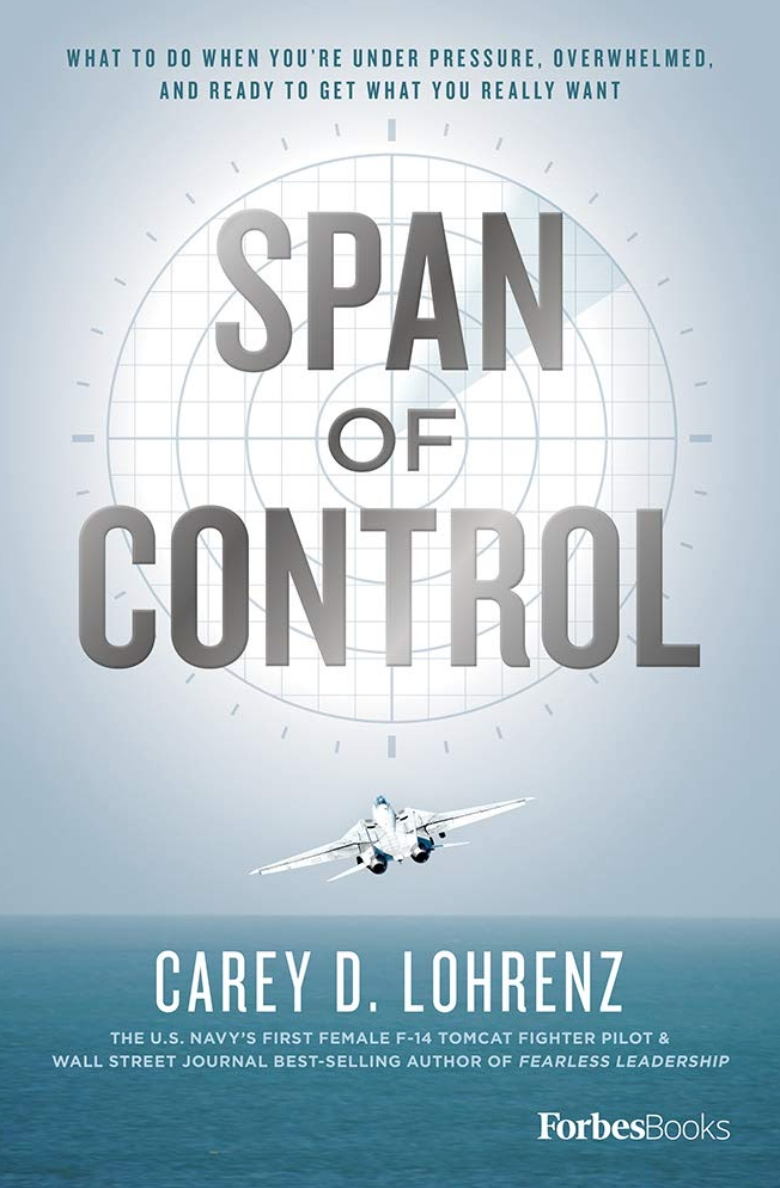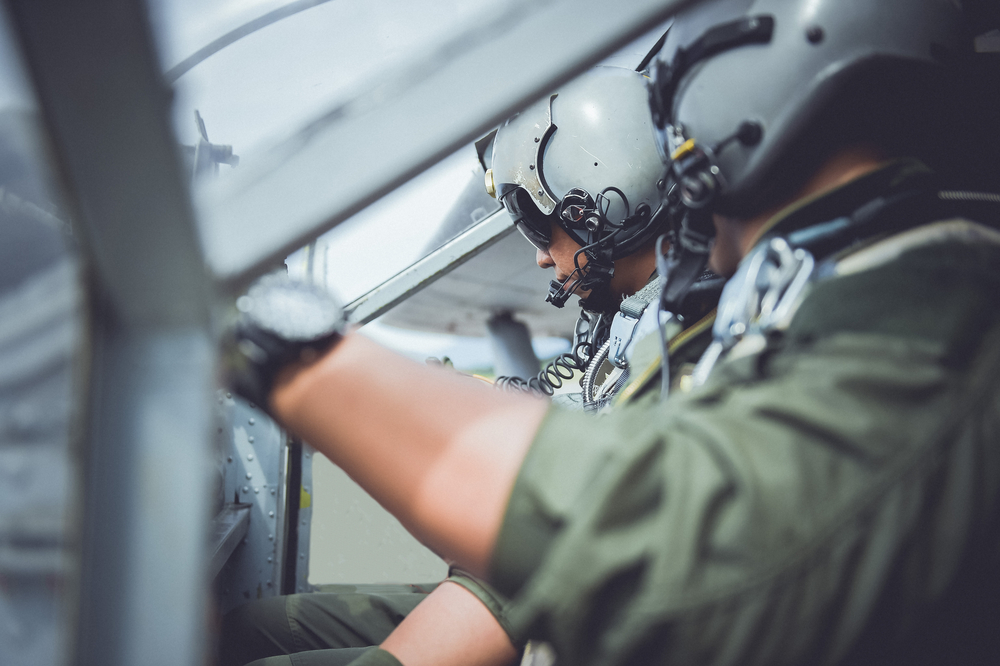I’m about to land my Tomcat, a supersonic twin-engine fighter jet, on the deck of an aircraft carrier. It’s one of the most dangerous maneuvers in all of aviation. That alone would be enough — my runway is shifting on the crest of each wave, and it feels like I am trying to fit an elephant through a keyhole — but it’s also the middle of the night, and the darkness is disorienting. As I fall from the sky at hundreds of feet per minute, I can barely see lights on the carrier, and there’s no hint of a horizon.
All I see is inky blackness.
The line of glowing points on the deck tilts side to side in a slow seesaw motion. The countdown begins. At three quarters of a mile, the landing signals officer (LSO) pipes up: “One zero five, on and on, three quarters of a mile. Call the ball.”
My radar intercept officer (RIO) answers, “One zero five, Tomcat ball, five-point-seven, Lohrenz.”
I steel myself, trusting my relentless preparation, practice, and experience to stifle the burning fear in the pit of my stomach. I don’t want to hit the water or the back end of the carrier — what we call a “ramp strike.”
The LSO calmly replies, “Roger ball, Tomcat, wind is twenty knots.”
Inside the cockpit, my RIO is calling out our rate of descent in feet per minute: “Six hundred … six fifty … six hundred … six hundred … six hundred … ” The goal is to be steady, on speed, on glide path to assure a safe landing.
As adrenaline courses through my veins and sweat wets my brow, my attention is pulled in a thousand different directions. In this moment, there are so many things outside of my control — the gusty winds, the overpowering darkness, the crashing waves, the moving target. But thanks to that dedicated training and preparation, I know to focus on three — and only three — critical things: meatball, line up, and angle of attack.
Meatball: the orangey light that tells me how close I am to the optimal glide path (i.e., either high or low).
Line Up: you “line up” on the centerline of the landing area of a carrier — a particularly challenging task, because it is canted seven degrees to the port side compared to the ship’s centerline. In order to stay on centerline, the pilot must continually correct to the right.
Angle of Attack (AOA): my wings’ angle in relation to the relative wind (on any aircraft, too great an AOA will cause the wing to stop flying, i.e., stall, as airflow across the top is disrupted). This angle determines how far the aircraft tailhook hangs below the eye of the pilot. Since every aircraft is different, it is critical for the pilot of each aircraft to fly “on speed” so the hook doesn’t move up or down and so that it catches the appropriate arresting wire as the aircraft touches down aboard the carrier.
It takes extreme hand-eye coordination, focus-shifting ability, and the resolve to hang in there no matter what, but I know that if I can take care of those three things — meatball, line up, angle of attack — I can increase my chances of landing safely.
At this moment, those three things are what’s within my Span of Control. Not the wind. Not the ocean. Not what my commander said that morning. Not what I’ll do tomorrow. Just meatball, line up, angle of attack. They intentionally become my whole world as my focus shifts from one to the other at hyper speed, hitting each of those things at nearly ten times a second!
Meatball. Next. Line up. Next. Angle of attack.
Boom! We hit the deck. I’m going 145 knots, nearly 170 miles per hour, when the arresting hook on my Tomcat snags a wire. I slam both throttles to full military power and click my speed brakes in, just in case my hook doesn’t fully engage the arresting wire, or the wire snaps and I have to attempt to get flying again. My body is slammed forward with such force that it feels as if my arms and legs are going to separate from my body. I come to a full stop in 1.2 seconds.
We’ve landed.
These landings are like controlled car crashes. The touchdown is enough to destroy most other airplanes — but not the F-14. United States Navy and Marine Corps fighter pilots are the only fighter pilots in the world who will land high-speed fighters on and off aircraft carriers at night.
No one else in the world will even make the attempt.
As you can imagine, there is a little bit of pressure.
Operating in the Pacific Ocean theater, you get the opportunity to experience some of the most treacherous swells and rollers found anywhere in the world. Oftentimes the backend of the aircraft carrier can be up and out of the water thirty-five to forty feet. Now, that may not seem like a big deal, but when you are coming aboard an aircraft carrier at nearly 170 miles per hour and you only have about six to eight feet of clearance to begin with? You have yourself an angles problem. The first time you see the back end of a carrier up and out of the water during the daytime, you’ll find your humility or your Jesus, whatever that may be.
Now imagine that same scenario at night, when you are a thousand miles away from shore and you cannot control the environment. Not the weather. Not the ship. Not your tasking. Not your communication system. Not your aircraft systems. Not your teammates’ reaction to stress.
Even for an experienced fighter pilot, night carrier landings are always a challenge. It never gets easy, nor should it. This isn’t landing on a ten-thousand-foot runway — this is landing on a bobbing three-hundred-foot-long … postage stamp.
The risks are high. There will always be uncertainty and uncontrollables — even catastrophes — that we have to work through. Risk is unavoidable when you are pushing the performance envelope — that is true in both fighter aviation and in life.
The only thing you can do to ever so slightly mitigate the tension and anxiety? Do it again. Over and over and over.
The good news is that learning to focus on our Span of Control is a skill available to us all. That repetitive practice, the relentless preparation, is all about pinpointing what is in our hands in order to make the best decisions possible. That’s why all fighter pilots, and many of the rest of us, resolve to be constantly learning. We continually leverage our experience, gather new insights and information, prepare and train for a better outcome.
Despite what some might want you to think, no one shows up on day one a fully qualified military fighter pilot — not even those folks who show up with hundreds of hours of civilian flight time thinking they are all that and a bag of chips.
Here’s how the training works: starting on day one, whether at the Naval Academy, in your ROTC program, or at Aviation Officer Candidate School, the training is a set of building blocks, one skill learned after another and always under some sort of pressure — fatigue, physical stress, academic stress, sleep deprivation — you name it. And, like most anything else, first you have to learn how to crawl, then walk, then run. The ultimate goal is to be able to operate successfully in extreme conditions: air-to-air combat, high-speed intercepts, close air support for ground forces, photo reconnaissance, and eventually, landing on the aircraft carrier at night.
Under pressure, you don’t simply rise to the occasion — you sink to the level of your training. Or at least that’s the idea.
But I’m getting way ahead of myself: first you have to make it through all of the phases of flight school that will even get you to that point. Flight training for a naval aviator takes around twelve to twenty-four months, depending on your training pipeline, i.e., aircraft designation (helicopters, propeller aircraft, or strike fighters [jets]). And in each phase — Primary, Intermediate, and Advanced — we had demanding academic classes and tests, were often flying multiple flights a day, and were constantly being evaluated.
As much as someone might have wanted to be a naval aviator, the funnel narrowed through attrition at each phase. While only the top 10 percent of each Primary class even had a shot at selecting the strike fighter pipeline — or getting into the strike fighter pipeline — even that didn’t mean you would get a slot. Ultimately, that decision was based on a combination of your grades and the “needs of the Navy.” So, competition was fierce from the get-go. It takes about two years, the longest of all training pipelines, to earn the coveted gold naval aviator wings in the strike fighter pipeline.
The good news?
Starting in Advanced Strike Fighter Training, we begin training to fly low and fast. Honestly, that was some of the most fun flying I’ve ever done. The speed rush is incredible; the adrenaline courses through your veins. You’re darting in and out of mountains and rolling through valleys. It’s a million-dollar ride each and every time.
Clearly, though, this type of flight in a low-altitude environment is both high workload and high risk. We’ve been training nonstop for almost two years in high-workload, high-stress environments, developing coping mechanisms, techniques, and tricks before we even get to this point. The Naval Air Training Command’s Flight Training Instruction for Low Altitude Awareness says this kind of mission “is an environment in which task saturation can overtake a pilot before there is clear awareness of developing danger.”
Task saturation or task overload is what happens when the number of things an aviator is asked to pay attention to outpaces the information-processing capacity of the brain. In other words, when there are way too many things begging for the pilot’s attention, if he or she were to focus on all of them, it would result in a major accident that would likely result in loss of life.
I share this with you so you can imagine what it is like to land on an aircraft carrier at night in the pitch-black inky darkness, or be whistling through the desert low and fast at speeds illegal in most every other part of the country, with less than a third of a second margin for error or time to impact. The lack of certainty. The anxiety. The tension. The adrenaline. The fear. The excitement. Everyone has a different physiological response to that fear. Some people taste it. Some people sweat. Some people vomit; some people vurp (a vomit burp). Other people’s hearts race. Some get goose bumps.
You’d be hard pressed to find an aviator whose palms haven’t gotten sweaty, who hasn’t felt that numbing, aching, pit-in-the- stomach feeling, who hasn’t gone around several times in the pattern after failing to trap (to land), specifically during nighttime carrier operations.
It’s happened to me. I’ve felt it. We all have. We even have a saying for it. We call it having your “night in the barrel.”
But all of us have to figure out how we are going to work through those feelings if we want to be successful. How do we maintain our focus on what’s most important, when just a moment’s inattention could mean catastrophe? In particular, how do we develop our capacity for targeted awareness?
The goal is to avoid ever reaching the point of debilitating task saturation, to keep a clear view of current and developing dangers, and to be able to complete your mission objective.
We’ve all experienced the feelings of dread, overwhelm, frustration, and stress, feeling like we’re drowning in too much to do with not enough time, tools, or resources to get the job done. Whether that overwhelm comes from information overload (too-much-data syndrome) or technical skill overload (when our brains prioritize and focus on a single thing in an attempt to regain control, to stabilize the situation), when you then throw in a handful of accelerating changes, stress, anxiety, and a pandemic? The net result is the same: the average person’s ability to multitask, or task switch, goes right out the window. That stress, that anxiety, narrows our perceptual field, limiting our ability and capacity to process any new information.
That stress can reduce the capacity of our working memory and inhibit information recall and long-term memory. In what’s known as the “strong but wrong effect,” stress can even cause you to revert to previously learned behaviors that may or may not be effective. Collectively, stress and anxiety conspire to thwart your ability to get the darn job done and can bring you dangerously close to being unable to execute your well-thought-out plan.
The military has spent a lot of time and money researching and mitigating task overload, and the most surprising thing, discovered early on, was that typically pilots weren’t even aware of its onset. They would reach cognitive overload and hit the ground (literally crash!) before they even knew what was happening.
But fighter pilots have developed coping mechanisms, techniques, and tricks that allow us to work through extraordinarily high task loads while under extreme stress. Which brings us to today and my need to share with you information about how to focus in on your Span of Control.
You might already be familiar with use of the term in the corporate world, where your Span of Control is the number of direct reports you can effectively manage at one time. But in the Navy, the idea is a lot broader and a lot bigger — even though the phrase itself is not regularly used.
Your Span of Control is determined by the things you can, and should, control at any given time. Everything else is just a distraction. Span of Control is how we reminded ourselves what to focus on right in the moment, knowing that anything else was outside our control and shouldn’t take up precious mental space. Recognizing our Span of Control kept us focused on what mattered most and became a primary tool in taming the distractions and pressures of flying demanding, high-pressure missions. In the Navy, your Span of Control not only kept you alive, it kept you loving your job and kept your mission and purpose clear.
But for me, Span of Control is more than a term — it’s a mantra. Over the years, this mantra took up residence in my soul and has been one of the biggest driving forces and motivators in my life — so much so I have “SOC” inked on the inside of my right wrist. Every time I feel overwhelmed, I glance down at those three letters to remind myself that I can only control so much and that the best way to conquer the chaos is to stay focused on those things I truly can control, right now, in this moment.
Why SOC? Why not just focus in pretty script? Why not concentrate or meditate in Sanskrit? Because it’s specific, it’s intentional, and it’s actionable. As I covered in-depth in my precious book, Fearless Leadership, action conquers fear.
Not just some glittery platitude, “Span of Control” has been the strategy, tool, framework, compass — the guiding force — that’s kept me sane, focused, and on task. It’s quelled depression, anxiety, and stress. It’s guided me through loss, grief, and heartache. It’s kept me excited about the things I am passionate about and eliminated the things that brought me down. It’s allowed me to see what could be, while navigating what is. And it saved my life more than one dark night above the choppy Pacific Ocean.



